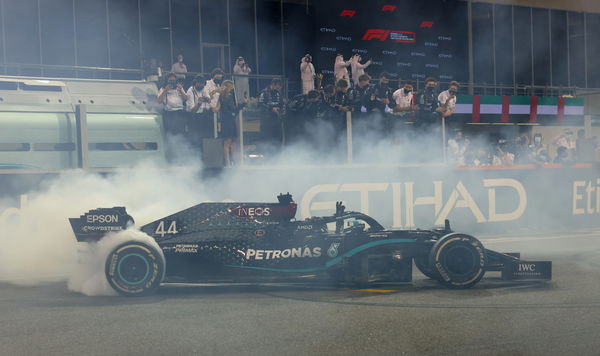
via Reuters
Formula One F1 – Abu Dhabi Grand Prix – Yas Marina Circuit, Abu Dhabi, United Arab Emirates – Mercedes’ Lewis Hamilton in action after the race Pool via REUTERS/Giuseppe Cacace

via Reuters
Formula One F1 – Abu Dhabi Grand Prix – Yas Marina Circuit, Abu Dhabi, United Arab Emirates – Mercedes’ Lewis Hamilton in action after the race Pool via REUTERS/Giuseppe Cacace
We’re living in the 2020s and many consider Formula One as one of the most dangerous motorsport series in the entire world. But, going back a decade, the cars were even scarier; The F1 drivers’ lives would always remain on the line from the moment they head onto the track from the garage.
And, here’s something interesting! The fear factor wasn’t just the case when cars were peaking at their highest speed but also in the pit lane where they would barely touch 60 mph. How you might ask? Refueling!
ADVERTISEMENT
Article continues below this ad
When was refueling banned in F1?
It was only in 2010 that F1 decided against letting teams refuel their cars during mid-race. But, in order to accomplish it, there was something that the F1 think tank was needed to do. It seemed almost impossible to ban refueling as the fuel tanks in the 2009 cars were just too small. Hence, in 2010, the cars were allowed to be 22 cm bigger to accommodate the enlarged fuel tank.
And this made life easier for the teams and also opened the floodgates to the concept of fuel strategy. Fuel management eventually became a huge factor as the drivers have since worked in tandem with their race engineers and strategists into bringing about the best possible performance out of the car using the allocated fuel load.
Why did F1 ban refueling?
In order to reduce the cost and also to increase safety, the FIA decided to ban it. So the F1 On race cars will follow the recent regulation that will enhance the race with a full tank of fuel. Prior to the ban, there were just one too many incidents in the pit lane that were caused by refueling. Fuel spillage, on several occasions, led to the cars going up in flames. Hence, the safety factor was one of the major reasons for F1’s decision to ban refueling.
The other reason being cost-cutting. Back then, every penny counted, and hence, moving heavy fueling equipment from one Grand Prix to another would lead to much bigger freight charges.
According to Romain Grosjean, the Haas F1 team racer, bringing back the refueling system could be of great help for F1. It will have the opportunity to resolve and fix the GPDA’s issues.
He stated, “Yes, we want it,” Further added, “Not because we think it’s great for racing but because we need to bring the weight of the car down to help Pirelli. It’s a temporary fix for the car to be 70 kg lighter or 60 kg lighter. It’s one of the reasons we are overheating the car like crazy.”

via Reuters
Formula One F1 – Russian Grand Prix – Sochi Autodrom, Sochi, Russia – Haas’ Romain Grosjean during practice Kirill Kudryavtsev/Pool via REUTERS
In addition, he remarked on the advantages of re-introducing the rule. Grosjean further asserted, “Yes. It will help the tires which is the big weakness.”
Further, there are several other theories from different drivers. Most of them spectated the era of refueling and support the refueling of cars.
According to the racers’ opinions, it is safer and more convenient to race with the light weighted car. Subsequently, it makes racing more comfortable, lowering down the risk factor too, in an aspect of tire dramas.
Will refueling return to F1?
Many proposed to have a meeting over the F1 strategy group. Further, in 2017, in order to ensure to enhance and Prove the show. Subsequently, all the ideas did not reach the aspired destination.
In the debate of refueling of cockpits in between races, pros and cons came up under the light. The argument in favor of refueling did not exceed the ones opposing it. Hence, as of now, refueling is something that might continue to stay away from F1.
Jos Verstappen came in for his pit stop. Fuel sprayed all over his Benetton which then erupted in flames. Luckily there were no serious injuries & the incident would be investigated by the FIA & Intertechnique. German GP, Hockenheim, 31st July 1994. #F1pic.twitter.com/NEHB1mKP6M
— F1 in the 1990s 🚦🏎🏁🏆🍾 (@1990sF1) July 31, 2021
It would be impossible to dispute the fact that the cost and safety drawbacks. Nevertheless, it would also be extremely difficult to argue that refueling would not make the cars quicker either. A lighter car is quicker for starting a race. Cockpits with 50 kilograms of fuel would be faster than the one starting at 100 kilograms.
As per the current maximum allowance, it would not make much difference if the lighter load allowed the driver to push his tires a little harder to tune on half of a second per lap.

via Reuters
Formula One F1 – Pre-Season Testing – Circuit de Barcelona-Catalunya, Barcelona, Spain – February 25, 2022 Mercedes’ Lewis Hamilton during testing REUTERS/Albert Gea
Do drivers want refueling in F1?
From the driver’s point of view, they would love to have a quicker, but they’re not the ones watching the races, so it doesn’t much make any difference to the ones viewing it. It would be incredibly unfair to put the recent upturn of moves down solely to the banning of refueling.
Our first trip to Singapore was a dramatic one for many reasons 🤯
Felipe Massa's title aspirations took a huge blow after this nightmare pit stop 😩 He led the race… but finished an unlucky P13#F1 #SingaporeGP pic.twitter.com/xzcxxoiokG
— Formula 1 (@F1) September 20, 2019
ADVERTISEMENT
Article continues below this ad
The arrival of three new teams in 2010 influenced the figures, while Pirelli’s designed-to-degrade tires and the DRS (Drag Reduction System) overtaking aid both arrived in 2011 and turned the whole sport on its head.

via Reuters
2018 FORMULA 1 SINGAPORE AIRLINES SINGAPORE GRAND PRIX (13 September 2018) – Zone 1 – Pitlane Experience General View Singapore Grand Prix via Reuters Plus
But it would be equally wrong to say refueling didn’t have any adverse impact on overtaking. Statistics can paint a misleading picture, but it’s rare for such a vast quantity of data to fail to give a truthful overall trend, and the view that refueling harms overtaking is backed up by a number of very experienced senior figures inside F1.
ADVERTISEMENT
Article continues below this ad
Formula One needs to attract new fans and henceforth the focus is on creating a greater impact on close racing with greater competition all the way through the field and bags on tracks action. This idea of banning refueling was also for creating chances for the struggling teams. Further, to avoid danger for the pit crew members and racers in the cockpit too.
Read More: Do F1 Cars have a Clutch?
ADVERTISEMENT
ADVERTISEMENT
ADVERTISEMENT
ADVERTISEMENT

